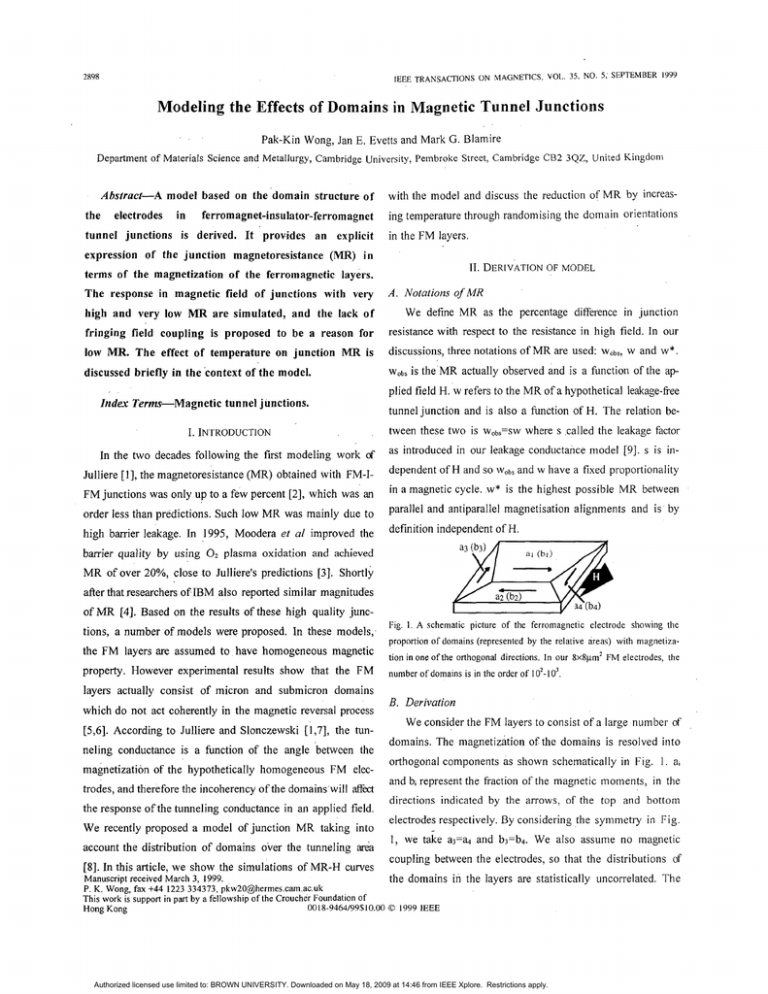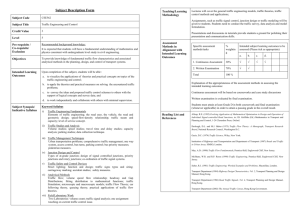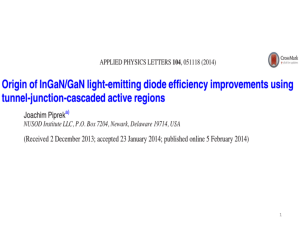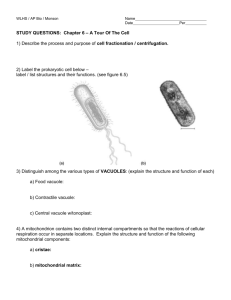Modeling the effects of domains in magnetic
advertisement

2898 ~ E E ETRANSACTIONS ON MAGNETICS, VOL 35, NO 5 , S!YEMBER 1999 Modeling the Effects of Domains in Magnetic Tunnel Junctions Pak-Kin Wong, Jan E. Evetts and Mark G. Blamire Department of Materials Science and Metallurgy, Cambridge University, Pembroke Street, Cambridge CB2 342, United Kingdom Abstract-A the electrodes model based on the domain structure of in ferromagnet-insulator-ferromagnet tunnel junctions is derived. It provides an explicit with the model and discuss the reduction of MR by increasing temperature through randomising the domain orientations in the FM layers. expression of the junction magnetoresistance (MR) in 11. DERIVATION OF MODEL terms of the magnetization of the ferromagnetic layers. The response in magnetic field of junctions with very A . Notations of MR high and very low MR are simulated, and the lack of We define MR as the percentage difference in junction fringing field coupling is proposed to be a reason for resistance with respect to the resistance in high field. In our low MR. The effect of temperature on junction MR is discussions, three notations of MR are used: Wobs, w and w*. discussed briefly in the context of the model. Webs is the MR actually observed and is a function of the ap- plied field H. w refers to the MR of a hypothetical leakage-fi-ee Zndex Terms-Magnetic tunnel junctions. tunnel junction and is also a function of H. The relation be- I. INTRODUCTION tween these two is wobs=sw where s called the leakage factor In the two decades following the frst modeling work 6 as introduced in our leakage conductance model [9]. s is in- Julliere [ 11, the magnetoresistance (MR) obtained with FM-I- dependent of H and so Wobs and w have a fixed proportionality FM junctions was only up to a few percent [2], which was an in a magnetic cycle. w* is the highest possible MR between order less than predictions. Such low MR was mainly due to parallel and antiparallel magnetisation alignments and is by high barrier leakage. In 1995, Moodera et a1 improved the definition independent of H. barrier quality by using O2 plasma oxidation and achieved MR of over 20%, close to Julliere's predictions [3]. Shortly after that researchers of TBM also reported similar magnitudes of M R [4]. Based on the results of these high quality junctions, a number of models were proposed. In these models, the FM layers are assumed to have homogeneous magnetic property. However experimental results show that the FM I Fig. I . A schematic picture of the ferromagnetic electrode showing the proportion of domains (represented by the relative areas) with magnetization in one of the orthogonal directions. In our 8x8pmZ FM electrodes, the number of domains is in the order of 102-10'. layers actually consist of micron and submicron domains which do not act coherently in the magnetic reversal process [5,6].According to Julliere and Slonczewski [1,7], the tunneling conductance is a function of the angle between the magnetization of the hypothetically homogeneous FM electrodes, and therefore the incoherency of the domains will affect the response of the tunneling conductance in an applied field. We recently proposed a model of junction MR taking into account the distribution of domains over the tunneling a&i [SI. In this article, we show the simulations of MR-H curves B. Derivation We consider the FM layers to consist of a large number of domains. The magnetization of the domains is resolved into orthogonal components as shown schematically in Fig. 1 . a, and b, represent the fraction of the magnetic moments, in the directions indicated by the arrows, of the top and bottom electrodes respectively. By considering the symmetry in Fig. 1, we take a3=a and b3=b4. We also assume no magnetic coupling between the electrodes, so that the distributions of Manuscriot received March 3. 1999. the domains P. K. Wong, fax +44 1223 334373, pkw20@hermes.cam.ac.uk This work is support in part by a fellowship of the Croucher Foundation of 0018-9464/99$10.00 0 1999 IEEE Hong Kong in the layers are statistically uncorrelated. The Authorized licensed use limited to: BROWN UNIVERSITY. Downloaded on May 18, 2009 at 14:46 from IEEE Xplore. Restrictions apply. 2899 total field-dependent junction conductance G(H) is the sum- than the MR peaks. The MR then decayed slowly in about 2 mation oftunneling contributions between domains of vari- days to the lowest and steady value (point B) between ous magnetization, 40-60% of the MR at point A. The temporal variation of the SO we write zero field MR can be fiozen at any point by immersing the G(H)=gap(aibz+azb1+2a3b3)+gp(alb I +azbz+2a3b3) +g,(2al b3+2azb3+2bI a3+2b2a3) junction into liquid (1) 5 where gap,g, and g, are conductance between domains of antiparallel, parallel and orthogonal magnetization respectively. Nz. 4 i h 5 3 a,bj is the probability of tunneling between domains indicated by a, and b, in Fig. 1. At a high enough field, al=bl=l and $ 2 1 all others vanish, giving a total conductance of G(H)=g,. O-3 Therefore w(H), defined as [g,-G(H)]/G(H), becomes Fig. 2. Initial MR-H curves. X, A and B correspond to MR values of Omin 20min and 2 days after the previous magnetic cycle. By writing the maximum possible MR between single do- The temporal variation of the initial curves can be ex- mains as w*=(gp-gaP)/gap, we have gadgp=(l + ~ * ) - ' ;and fiom plained by (3) and (4) in view of the minimisation of the total the dependence of MR on the angle between the magnetiza- magnetostatic energy of the system. In Fig. 2, point X corre- tion [7], we have g,/gp=( l+w*/2)( l+w*)-'. By putting the sponds to partially parallel magnetization, i.e. O<M,, Mb<l. expressions of gaP/gpand g,/g, into (2), we obtain The system frstly reduced its energy by forming antiparallel magnetization, i.e. M,Mb=-l, giving the highest MR of w* w(H)=( I+w*)(uw*+ l)-'-l ( 3) from (3). This antiparallel alignment is possibly promoted by u=a3+al(bl+b3)+az(bz+b3)=( 1+MaMb)/2. (4) the fringing field coupling of the electrodes suggested by In (4), Ma=al-az and Mb=bl-bZ are the magnetization of the Tsuge et a1 [lo], whose junctions have similar nominal FM electrodes normalised to their saturation values. There- structure as ours. To eliminate further the fringing flux, the fore (4) gives explicitly the relation between junction MR and domains in each FM layer reorganised to form closed flux the magnetization of the constituent FM electrodes. loops, i.e. M,=Mb=O, giving w(H)=w*(w*+2)"=0.41~* (or where 41% of w*). This is calculated with w*=46.3% for Fe-CoFe 111. COMPARISONS WITH EXPERIMENTS A . Initial MR-H Curves We have observed temporal variations of MR in our 8pmxSpm Fe/A1203/CoFe mesa junctions with multiply oxidised barriers [8,9]. Apart from the usual hysteretic MR-H peaks, the junctions showed initial curves, starting from zero to high field (Fig. 2), similar to those seen in spin valve multilayers. The MR of the initial curves at zero field depend on the duration of waiting after the previous magnetic cycle. In Fig. 2, point X on the hysteretic curve is the MR immediately after a magnetic cycle. That zero field MR rose in 20-30 min to its highest value (point A)'which was 0-9% higher junctions predicted by Julliere's formula [ 11. This agrees well with the ohervation that the steady zero field MR is 40-60% of the highest value. B. Simulation of MR-H Curves With (3) and (4) the MR-H curves of a FM-I-FM junction can be simulated with the normalised magnetization of the electrodes. As examples, we simulated the results of CoFe/A1203/Cojunctions in [3] and Ni/A1203/Cojunctions in [ l l ] , which are examples of very high and very low M R respectively. From Fig. 3, the simulation agrees very well with the low MR results except by a proportionality factor explainable by the leakage factor mentioned in IIA. For the Authorized licensed use limited to: BROWN UNIVERSITY. Downloaded on May 18, 2009 at 14:46 from IEEE Xplore. Restrictions apply. 2900 high MR case, the anisotropy magnetoresistance (AMR) d room temperature. Increasing temperature tends to 'randomise the FM layers quoted in [3] are used instead of the magnetiza- the alignment of domains along H and therefore lowers the tion (M), and we assume a proportionality between AMR(H) MR shown by the junction. This is consistent with a recent and M(H). Good agreement is obtained in regions beyond the theory that MR is lowered by temperature rise through effects coercivities of the individual FM layers. In between the coer- on the FM-I interfacial magnetism [ 121. civities, the measured MR increased sharply to beyond the REFERENCES simulated values. Since this discrepancy occurs only between the coercivities (not other regions), it is probably due to fringing field coupling of the electrodes [lo], which is assumed negligible in the derivation of (3) and (4). The above M. Julliere, "Tunneling Between Ferromagnetic Films," Pbys. Lett., vol. 54A, pp. 225, 1975. R. Meservey and P. M. Tedrow, "Spin-Polarised Electron Tunneling," Phys. Rep., vol. 238(4), pp. 175, 1994. simulations imply the important role of fringing field cou- J. S. Moodera, L. R. Kinder, T. M. Wong and R. Meservey, "Large pling in achieving high MR peaks and high MWH sensitiv- Magnetoresistance at Room Temperature in Ferromagnetic Thin Film Tunnel Junctions," Pbys. Rev. Lett., vol. 74(16), pp. 3273, 1995. ity. S. S. P. Parkin, R. E. Fontana, A. C. Marley, "Low-field magnetoresistance in magnetic tunnel junctions prepared by contact masks and CoFdAl, 0,ICo :30 : simulation 120 z2 s. E -.10 a h lithography: 25% magnetoresistance at 295K in mega-ohm micronsizedjunctions," J. Appl. Pbys., vol. 81(8) Pt. 2B, pp. 5521, 1997. J. Nowak and J. Rauluszkiewicz, "Spin dependent electron tunneling between ferromagnetic films," J. M u p . Mugn. Muter., vol. 109, pp. 79, 1992. S. A. Rishton, Y. Lu, R. A. Altman, A. C. Marley, X. P. Bian, C Jah- -600 -400 -200 0 200 400 600 nes, R. Viswanathan, G. Xiao, W. J. Gallagher, S. S. P. Parkin, H (Oe) 0.08 "Magnetic Tunnel Junctions fabricated at tenth-micron dimensions I I by electron beam lithography," Microelect. Eng., vol. 3 5 , pp. 249, 0 07 1997. 5 006 h U 2 2 J. C. Slonczewski, "Conductance and exchange coupling 01' two 005 004 ferromagnets separated by a tunneling barrier," 003 39(10), pp. 6995, 1989. 002 P. K. Wong, J. E. Evetts and M. G. Blamire, "Modeling for Magnetic 0 E 9 0 01 -120 P/7ys. Rev. B. vol. Tunnel Junctions with Multidomain Ferromagnetic Layers," unpub-80 -40 0 40 80 lished. I20 H (Oe) P. K. Wong, J. E. Evetts and M. G. Blamire, "High conductance Fig. 3. Simulations of the MR-H curves of junctions showing very high [3] and very low [I 11 MR. i Iv. DISCUSSIONS AND CONCLUSIONS From the discussions in sections 111, we conclude that the magnetoresistive tunnel junctions with multiply oxidised barrier," J . Appl. Pbys., vol. 83(1 l), pp. 6697, 1998; P. K. Wong, J. E. Evetts and M. G. Blamire, "High conductance small area magnetoresistive tunneljunctions," Appl. Phys. Lett., vol. 73(3), pp. 384, 1998. H. Tsuge and T. Mitsuzuka, "Magnetic tunnel junctions with in sihr present model describes well the effect of domain orientation naturally-oxidised tunnel barrier," Appl. Pbys. Lett., vol. 71(22), pp. on the MR behaviour of magnetic tunnel junctions, when the 3296, 1997. coupling of the electrodes is insignificant. In section 11, we Y. Suezawa, F. Takahashi and Y. Gondo, "Spin-Polarfsed Electron Tunneling in Ni/A120JCo Junction and Large Magnetoresistance of reported a maximum initial MR of upto 9% higher than the Ni/Co Double Layers," Jpn. J. Appl. Phys., vol. 31(2) No. IOA, pp. peak MR. In the context of our model, this implies an in- L1415, 1992. complete alignment of domains along H at the MR peak. The C. H. Shang, J. Nowak, R. Jansen and J. S. Moodera, "Temperature temporal variation of initial .MR at room temperature implies that the domain orientation is subject to thermal agitation at dependence of magnetoresistance and surface magnetization in ferromagnetic tunnel junctions," Phys. Rev. B. vol. 58(6), pp. R2917, 1998. Authorized licensed use limited to: BROWN UNIVERSITY. Downloaded on May 18, 2009 at 14:46 from IEEE Xplore. Restrictions apply.





